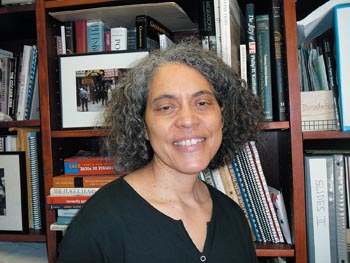Main Street, the Historic East End Neighborhood and the Wooly Adelgid
 |
| Dr. Mindy Fullilove, professor of clinical psychiatry at Columbia University, and author of “Root Shock.” |
by Mindy Thompson Fullilove, MD
In 1970 Andrea Clark got a camera and started to take pictures of the East End neighborhood in which she visited her father and his family (see The Urban News, February 2009). One thousand of these photographs were recently given to the Pack Memorial, a treasure chest of images of an area that was destroyed to widen a road .
Remembering the past
The historic East End neighborhood draped two hillsides adjacent to downtown, an area that was scooped out for the road and left barren. During a visit to Asheville from February 27 to March 3, I had the opportunity to walk around the area. Asheville downtown is precious, in the sense of “affectedly dainty or overly refined,” a definition offered by the Free Dictionary online .
There is a drug store and a phenomenal bookstore, but that is pretty
much the end of its utility. The rest of the stores and restaurants are
“destinations” for tourists and well-heeled area residents.
I could locate a point of connection between the East End and
downtown in a faded Coca-Cola sign that Andrea Clark had photographed
decades before. Now the sign seemed to hover over a precipice,
descending into the barren hollow, which felt menacing because it was
steep and empty.
What a contrast to the area as depicted by Clark! Then it was a
dense neighborhood, crammed onto the hills, but with space for
vegetables, stores, bikes, bands, and people. Black and white photos
are rare in this era of color, but their starkness made the life more
vivid. I was whisked into the corner store, and onto the sagging
porches. The wise eyes of elders and shining eyes of children gazed
frankly into mine. It was very urban, in the sense of civilized and
unexpected.
Present And Future Challenges
Challenges to ecosystems are constant and come from many
directions: I read in the newspaper about the infestation of wooly
adelgids that are threatening the hemlocks around Asheville. As this is
the dominant tree of the area, the whole ecosystem is threatened with
change. All kinds of plants and animals will disappear, and others will
move in. The austere look of hemlocks will disappear. Hillsides denuded
of coverage will be more likely to erode and collapse. The implications
are endless.
I also read in the newspaper that issues of a new downtown plan
were being debated – particularly the question of what heights new
buildings might have – and so I visited the website, wondering what
they planned to do about the cutoff of the East End. I found a map that
outlined the area of interest, and but this did not reach out to repair
the breach. I reacted to this as a physician, uncomfortable at physical
mutilation that was not to be repaired. See the final plan (PDF).
Putting It Together
The historic East End, the wooly adelgid, and the Downtown Plan:
these three chunks of information have been rattling around in my head
since my visit at the end of February. How do we fit such pieces
together?
In April, I hosted the US visit of Michel Cantal-Dupart, a
renowned French urbanist, who is one of the planners working on the
historic “Grand Pari,” the development of a plan for the greater Paris
region. Grand Pari, which means “Big Bet,” is the world’s most
important exercise in thinking about the future of cities. It has that
stature because it was convened by the President of France; involves
hundreds of mayors, architects, planners, engineers and others who care
for the magnificent cities of France; will guide investment; and by
changing the cities of France, will push development in cities all over
the world.
Cantal-Dupart gave a lecture to my students at the Mailman
School of Public Health. He suggested that we can use the three-ringed
borromean knot to study problems of the city, the rings in this case
standing for the historical, the real, and the imaginary. Where they
meet, Cantal-Dupart says, is the trough of desire, what we wish for in
the city.
In his system, Clark’s photographs of the East End are the
history, the wooly adelgid is the current real challenge, and the Main
Street plan is the imaginary vision for the future. Where they
intersect is what we must name, in order to make the sustainable city
of the future.
Cantal-Dupart demonstrated how this is done in a week of consulting in
Orange, NJ, a small post-industrial city on the outskirts of Newark.
Standing over a Colonial era tombstone dated 1745, Cantal-Dupart said,
“The cities of the future have a history: they must lean on that
history as they plan.”
He took us to the local park and pointed out that it was fenced
on one side, but not the other. That was not an accident. Rather, the
history of the fences was the history of segregation, manifested in a
park that was open towards the white neighborhood, but closed towards
the black neighborhood.
“Urbanists have the job of overcoming barriers,” he insisted to
all of the assembled leaders of the city, “and we who are older have
the responsibility to teach about the horrors of injustice.” He took us
to the Orange train station, which was used by Thomas A. Edison, whose
factory and home were nearby. “We must plan thinking far into the
future, as Edison did.”
What emerged, to symbolize this, was a historic photo of a large
crowd gathered around a gazebo to hear the then president of the United
States give a speech. This is a striking parallel to the lovely photo
in the Asheville Master Plan of a diverse group of people gathered
joyously in a plaza in the center of downtown. Oddly enough, we cannot
get to that glorious future by a direct route but, instead, must pass
through conversations about the historic East End and the wooly
adelgid.







